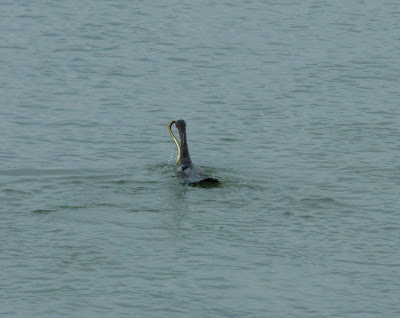On my way to Shoreham Beach to work with a group of students I noticed this cormorant eating an eel.
The eel put up a good fight before it was eventually swallowed whole.
I had been working with the school at Midhurst the previous day studying the grounds as a wildlife habitat and recording the various invertebrates we could find. Today we would be doing the same set of activities on the vegetated shingle at Shoreham.
However, first of all we explored the intertidal zone.
When we arrived an egret hunted along the edge of the incoming tide.
We would not have long to explore before the tide came in.
The children found a variety of marine life in the short time.
A amphipod, related to sand hoppers. Not dead, just laying on its side. They swim on their side and also wiggle along on their side when on the sand.These children find and photograph a shore crab
They also explore the rocky walls and sea defences covered in seaweed and inhabited by periwinkles , limpets, sea anemones and other wildlife.
And more shore crabs
After lunch we explored the vegetated shingle beach
The children drew a plan of the beach habitat to compare with their school grounds habitat.
Then they investigated the shingle plants and their special adaptations
This is woody nightshade, a relative of deadly nightshade
The children also investigated the invertebrates to compare with species they recorded in their school grounds.
Solitary bee
Hoverfly
They also recorded the bird life
Green finches
House sparrow
Ringed plover - wading birds.
Tomorrow, the children will be going to Iping Common to study the wildlife there and compare what they see with today's records and the records of their school grounds wildlife.

























1 comment:
Amazing captures here! I initially noticed your "cormorant vs eel" series! Wow that looked like a huge eel putting up some fight for the bird. In the end picture was the eel swallowed still desperately wriggling the whole way down?! I wonder if the unlucky prey would have any chance if eaten in that condition as well??
-Kyle
Reply: Mexicankyle35@gmail.com
Post a Comment